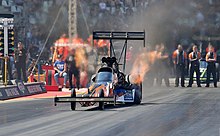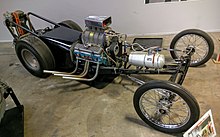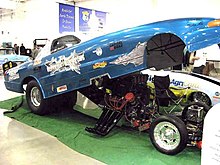Drag races

A drag race , drag racing or drag racing is a motorsport event for cars and motorcycles, in a straight line is to cover as quickly as possible from a standing start. The traditional racing distances are the quarter mile (402.34 m) and the eighth mile (201.17 m). The races of the upper amateur classes as well as the professional classes are contested with dragsters and drag bikes that produce up to a few thousand hp or kW. The speed of reaction of the drivers as well as their ability to bring the enormous performance of the dragster to the specially prepared drag strip decide between victory and defeat.
history
The drag races began in the first few years after the Second World War . At that time, it was fashionable for teenagers in the United States to engage in illegal street races in souped-up cars. In films like ... because they don't know what they are doing or American graffiti , this is the subject. Usually, two vehicles started at a traffic light at the same time and accelerated to an agreed destination, such as the next traffic light or the end of the block. The competitions were soon held in a legal framework and mainly relocated to airfields that were available in large numbers after the end of the war. In Southern California, dry salt lakes were also used as race tracks. The first specially designed drag race track opened in 1950 at an old airport in Santa Ana , California . This type of pastime also became a popular pastime among American soldiers in Great Britain and Germany. Cheap and light pre-war models such as the Ford Model A were preferred . In order to reduce the weight, all body parts that were not absolutely necessary, such as the fenders, bonnet or hood, were removed. The engine was upgraded or replaced by a modern V8 unit. During this time attempts were made with several engines in a dragster, but with a few exceptions (e.g. Tommy Ivo's "Showboat" dragster) they were unsuccessful. Based on these as Hot Rod designated "hot rods" in 1951 in California, the National Hot Rod Association founded (NHRA), which since then is the largest organization in drag racing. The second largest organization in American drag racing is the International Hot Rod Association (IHRA) with about a third the size of the NHRA.
From the late 1950s through the 1970s, muscle cars in the United States were factory tuned to the quarter mile. The best-known representatives are the 1969 Dodge Charger , the 1970 Plymouth Hemi Cuda and the 1969 Chevrolet Camaro Yenko . The latter held the quarter mile record with 11.82 seconds for years. This makes it the fastest production car on the quarter mile. Even the 1970s Chevrolet Chevelle SS with the up to then largest series engine from Chevrolet with 7.4 liters displacement (454 CID ) and 450 HP (331 kW) was not able to undercut the Camaro.
competition
Regulations
The technical rules in drag racing appear to be complicated for outsiders at first, because, unlike e.g. B. in formula racing, where the vehicles have the same cubic capacity (often also the same engine) or other identical specifications, in drag racing very often the most diverse concepts have to be brought to a "common denominator". The current versions are available online on the DMSB, FIA and FIM websites.
The sporting process is much easier: "Two go in - one comes out" - After a ranking list has been created in several qualifying rounds (in which only the running time is counted), the drivers compete on the actual race day ("Eliminations") in knockout system against each other. The respective pairings are specified in flow charts (also known as "Ladders" / "Ladders"). The fastest competes against the last, the second fastest against the penultimate, etc. In contrast to the qualification, the reaction time at the traffic lights is added to the (net) running time. This adds the aspect of driving know-how to the purely technical component , which often determines the result. The respective winners meet in the next round until the day / event winner is determined in the final.
Amateur classes
The rules for the amateur and sportsman classes are determined by the DMSB . The amateur classes encompass a wide range of vehicles, from road-legal series vehicles to racing cars specially designed for drag racing. In order to counteract the increasing upgrading of vehicles and to limit costs, most classes are driven according to a time index. The drivers must try to get as close as possible to the given time. Falling below the index leads to disqualification. This also enables races between vehicles of different strengths. The driver often has to take off the accelerator before the finish in order not to fall below the index. The decisive factor is then more the ability of the driver and less the engine performance of his vehicle. In the bracket races , the slower vehicle starts so much earlier that the more powerful vehicle can catch up with the less powerful vehicle at the finish line.
Professional classes
In 1997 the FIA introduced a European drag racing championship for the Top Fuel Dragster , Top Methanol ( joint since 2017 for Dragster and Funny Cars ), Pro Modified and Pro Stock classes . For this purpose, the FIA cooperates with the American NHRA and adopted their competition rules and technical regulations. The classic distance for drag racing is a quarter mile , which corresponds to 402.34 m. In 2012, the FIA adopted the NHRA rule specifically for the Top Fuel class, which stipulates a shorter race distance of 1000 feet (304.80 m) for safety reasons. The run-off zone connects directly to the actual route, the length of which must currently be at least 650 meters for FIA-certified routes. Where no straight line of this length is available or only less powerful vehicles compete, one is often content with half the distance of an eighth of a mile, corresponding to 201.17 m. Usually two drivers compete against each other. According to the times (Elapsed Time, ET) in the qualification runs, the pairings for the elimination runs are determined, which are then carried out in the knockout system . The reaction, intermediate and end times are measured separately for each lane using several light barriers . In particular, the reaction time at the start often decides whether you win or lose.
Race sequence
The race begins with burnout . The drivers briefly give full throttle, causing the wheels to spin and bring them to the optimum operating temperature. This is followed by staging , the taking of the starting position. Two white lamps controlled by light barriers indicate the position of the vehicle. When both racing cars have reached the correct position, three yellow lights on the start lights light up, one after the other or simultaneously, depending on the class. Then after a random period of time or by the race director, the start release is given by a green lamp.
Timing
From the time that elapses until the front of the vehicle passes the starting line, are, depending on the class of 0.500 or 0.400 seconds as a reaction time ( Reaction Time withdrawn, RT) such that the optimum RT 0.000 seconds. If the car has crossed the start line earlier, it is assumed that the driver did not react to the green light, which takes a person at least three tenths of a second, but drove off on suspicion. This is punished with a disqualification and indicated by a red lamp. The first intermediate time measurement for information purposes ( time slip , time sheet) takes place after 60 feet, corresponding to about 18 meters. The Pro-Class dragsters reach this point in less than a second and are then already over 100 mph (161 km / h). Another measurement of time and speed is typically made in the middle of the route. The winner is shown to the spectators in the starting area on a display board. In addition, the time elapsed from crossing the start line to reaching the finish line ( Elapsed Time , ET) and the final speed are displayed. The sum of Reaction Time and Elapsed Time is decisive for victory. One speaks of a hole shot when an opponent who was faster on the track was defeated by a quick reaction time.
Amateur classes
Junior dragster
The Junior Dragster (JD) class serves primarily to promote young talent and to introduce them to the subject of sport. It is divided into several sub-categories that relate the age of the pilots (between 8 and 16 years) and the performance of the engines. The machines produce up to 35 hp and sometimes reach speeds of over 120 km / h. A time handicap ensures equal opportunities in the races. The best drivers achieve reaction times at the starting lights that are in the low thousandth range.
Public Race, Modified Public, Street Eliminator
In the Public Race class, participants can compete in series vehicles that are faster than 16.50 s but slower than 11.99 s on the quarter mile. At the finish line, the drivers reach speeds of up to 180 km / h. In this class, spectators can also compete with their cars. The Modified Public class is reserved for modified series vehicles that are faster than 12.00 s but slower than 10.90 s. The engine and chassis can be modified in both classes, but the changes must be documented in the vehicle registration document. Racing tires are allowed in the race whose unusual grip on the grippy track reveals a weak point in the power transmission for some. The classic in the amateur field is the duel of high-volume US muscle cars against easy, with Porsche parts by and turbocharger upgraded VW Beetle and Japanese sports cars such as Nissan Skyline and Toyota Supra . Front-wheel drive vehicles have design-related disadvantages at the start, but can often make up for this by the way to the finish. The 10 second class for cars with over 1,000 hp has not been held at the NitrolympX at the Hockenheimring for several years. In Germany, drivers have teamed up in a self-organized Street Eliminator series.
Super Street, Super Gas, Super Comp
Far-reaching modifications to the engine and body are permitted in the Super Street, Super Gas and Super Comp classes. Pure racing cars are also used. For these classes, time indices of 10.90 s (Super Street), 9.90 s (Super Gas) and 8.90 s (Super Comp) are specified for the quarter mile. In the race, the drivers must try to get as close as possible to the given time. Falling below the time index leads to disqualification, which prevents an arms race. Any car engine is permitted as a drive, turbochargers and Roots-type compressors can be used for supercharging . The engines can be operated with gasoline, gasoline-alcohol mixtures, methanol or nitrous oxide . The minimum weight of the racing car depends on the class and the number of cylinders. The higher the class, the lower the minimum weight, the higher the number of cylinders, the higher the minimum weight. In the Super Street and Super Gas classes, the drivers compete with modified road vehicles or roadsters, in the Super Comp class with specially designed dragsters.
ProET, Super ProET
Extensive modifications are allowed in these two most widespread classes. Vehicles that drive the quarter mile between 9.00 and 11.99 s start in the Pro ET (PET) class. The Super Pro ET (SPET) class is intended for faster vehicles that need 6.00 to 8.99 s for the quarter mile. In contrast to the above-mentioned classes, each participant determines his own personal index, which must be passed on to the timekeeping system before each race. In addition, the elimination runs are started with a time delay, in the so-called "handicap start". This means that the slower opponent at the start light gets the time difference between the two indices as a lead. If both opponents drive the quarter mile with exactly their index time, they would have to drive through the goal at the same time, but the reaction time is often decisive for victory. Undercutting one's own index (break-out) leads to disqualification in the elimination run.
Competition Eliminator
The highest amateur class is Competition Eliminator . Each vehicle has an individual index based on various parameters such as cubic capacity, weight, fuel or charging technology. In contrast to other index classes, the aim here is to undercut your own index as far as possible. All types of vehicles are allowed, dragsters, door clamps and roadsters. The dragsters with their long wheelbase are similar to the dragsters of the professional teams, while the so-called Altereds come up with a specially made or heavily modified body. The minimum weight of the dragster is 612 kg for V8 engines, 454 kg for 6-cylinder engines and 386 kg for 4-cylinder engines. The minimum weights of the altereds are a few hundred kilograms higher. A typical engine is a turbocharged V8 engine with a displacement of 4.6 l. The most powerful vehicles produce up to 1500 hp. Due to the comparatively low weight, quarter mile times of less than seven seconds are possible in this class, with speeds of over 300 km / h being achieved. In the amateur field, this racing class places the highest demands on material and technology as well as the financial resources of the teams. Engines, chassis and the rest of the technology are stressed to the extreme, which often leads to major engine damage in the races.
Gallery of amateur classes
Professional classes
The FIA professional classes are:
- Per floor
- Pro Modified
- Top Methanol Funny Car
- Top methanol dragster
- Top Fuel Funny Car
- Top fuel dragster
The times for the quarter mile range from about 7 seconds to under 5 seconds. Over the 1000 Feet Top Fuel distance, times of less than 4 seconds are even achieved. In the USA in particular , the Pro Stock class is very popular with viewers due to its similarity to the corresponding series vehicles and the strong field of competition. In Europe, on the other hand, dragsters of the Pro Stock class are only represented in small numbers, in most cases the teams come from Scandinavia.
The top fuel class dragsters reach more than five times the acceleration due to gravity after takeoff . Together with the jet dragsters, they are among the fastest accelerating vehicles. When it comes to acceleration, Formula 1 racing cars can by no means keep up with dragsters.
Racing events

The drag races of the professional classes are held on specially prepared racetracks, the drag strips . These races are subject to the strict restrictions of the FIA or the NHRA and are partly included in the evaluation of European championships. The races at the Santa Pod Raceway in Podington, England, and the NitrolympX , which takes place every August at the Hockenheimring, are the largest events of this kind in Europe and part of the European Dragster Championship . In Scandinavia, professional races are held in Mantorp in Sweden , Gardermoen in Norway and Alastaro in Finland .
In addition to the professional events, various amateur races are organized according to the rules of the DMSB , in which anyone can participate. In Germany these usually take place at airfields. As part of the Nitrolympics at the Hockenheimring, vehicles with over 1,000 hp in the class up to 10.90 s compete and reach the finish line at well over 200 km / h. Due to the high engine power and the grip of the drag strip, the riders repeatedly experience wheelies , the front wheels getting on . However, powerful production cars or more recent sports cars, such as Porsche, are almost never at the start.
Drivers and records
In 1950, Don Garlits , at that time a factory driver for Chevrolet , drove a vehicle designed purely for acceleration races on a specially designed drag strip for the first time. Garlits, the pioneer of drag racing as a designer and driver, was also the first to break the 200 mph mark (321 km / h ) in 1964 . At the beginning of the 1970s he moved the engine of the fastest and most dangerous dragster behind the driver and also developed the fire-resistant suit, which was soon adopted by racing drivers around the world.
Apart from chess and horse riding, women and men only compete against each other in motorsport . American Shirley Muldowney was the first woman to compete in the NHRA championship and won four titles. She is considered the first lady of drag racing. Her life was filmed in 1984. The currently most successful driver is the American Tony Schumacher, who is supported by the US Army .
For more information on records, see: Section Records in Dragster
See also
Individual evidence
- ↑ http://www.street-eliminator.com/
- ↑ Regulations ET Bracket Racing . Website ProET . Retrieved December 2, 2013.
- ↑ http://www.eurodragster.com/timing/europeanbests/2019.htm
- ↑ https://www.focus.de/sport/formel1/tid-30029/formel-1-technik-und-ffekten-gewicht-top-speed-und-bedarf-der-boliden-von-0-auf-200 -in-five-seconds_aid_938271.html











